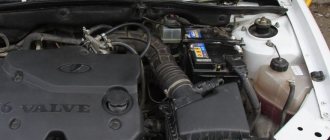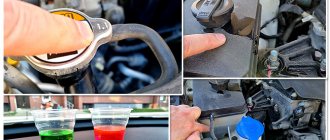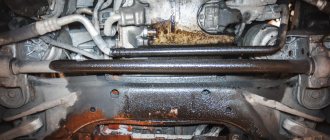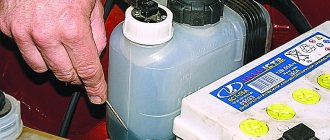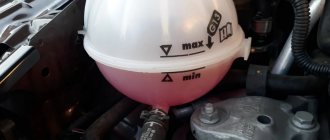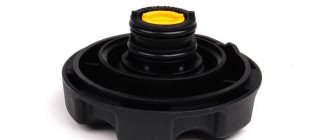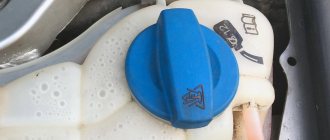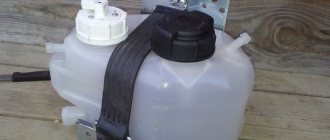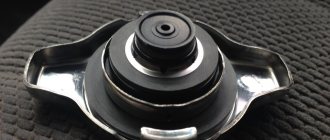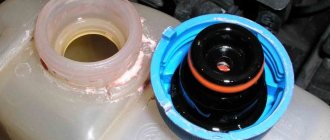Antifreeze is the key to the successful operation of not only the cooling system, but the entire car. The condition of the engine depends on its correct level and the quality of the coolant itself. Therefore, you need to carefully monitor the amount of antifreeze in the car: this will avoid problems, breakdowns and expensive repairs in the future. Many motorists sooner or later encounter a situation where the antifreeze has left the tank, but why this happened is unclear. There are several common reasons why refrigerant runs out.
Leaks
If the tightness of the cooling system is broken, liquid will immediately begin to leak and leave the expansion tank. Most often, a breakdown can be determined even by eye: characteristic stains and smell will tell you exactly where the antifreeze is missing. But in hard-to-reach places, the leak may not be detected immediately. You can carry out the initial diagnosis of the breakdown yourself, but in any case it is better to take the car to a specialist for repair. A leak is always a risk of a large-scale problem and major repairs.
it is important! In any case, if the antifreeze runs out, you should not leave the situation to chance: this often indicates a serious problem, and continuing to drive the car as if nothing had happened means risking the engine and your own safety. Ignoring the problem may result in the need for major repairs.
Radiator.
This is one of the parts that leaks most often. Such a breakdown is always easy to diagnose: stains and smudges begin to appear under the car. The bright colors of antifreeze will allow you to immediately determine that it is not water or gasoline, but rather coolant. Damage can be localized on the sides of the radiator or in the honeycomb tubes. On cars with high mileage, the cause of such a leak may be corrosion that has eaten through the walls. In any case, it is worth replacing the part so as not to risk your safety.
Radiator.
If there are no leaks under the car, but the coolant still disappears somewhere, this may be a symptom of problems with the heater. If you decide to carry out diagnostics yourself, first of all you need to inspect the interior. Antifreeze may drip onto the gasket near the front passenger seat. If the inside of the car smells sweetly, and the windows quickly begin to fog up and a coating appears on them, these may be signs of a breakdown. If you remove the dashboard, there may also be coolant leaks underneath. If a leak occurs between the gaskets or the faucet, you can replace this part.
Connecting elements.
Rubber hoses, tubes and pipes through which antifreeze circulates are constantly exposed to corrosion. If the car is used constantly, they are subject to a lot of stress. Then the service life of the connecting elements will decrease and they will wear out faster. Such parts are usually considered consumables, so they should be replaced if a leak is detected. Metal pipes can last longer because they are more durable. But in any case, corrosion and temperature changes will sooner or later lead to the occurrence of microcracks. Visual inspection of all hoses is not always possible: when diagnosing yourself, use a mirror to look into hard-to-reach corners.
Thermostat and pump.
They pump and regulate the flow of antifreeze into the cooling system, so they are constantly exposed to contact with it. These parts are most often made of plastic or metal. Due to heavy loads on them, defects may gradually form on the thermostat and pump, leading to leakage. Sometimes the knot is tightened too tightly, this increases its wear. Most often, it is not the parts themselves that leak, but the gaskets and seals. To determine the area of the leak, you need to inspect the engine and the lower part of the system: there may be antifreeze leaks on them. Repairing the thermostat and pump is almost impossible, so they will also have to be replaced.
Expansion tank.
This part is usually made of plastic, and this material is not very resistant to heavy loads. It can crack over time or wear out due to friction from moving parts of the car. Such a breakdown in the area of the expansion tank is easy to notice due to antifreeze drips. If the plug that seals it fails, the system is no longer airtight. Then the pressure in it drops, and the coolant begins to leave the tank as the car moves. Sometimes diagnostics require removing a part to check its lower part. If the bypass valve built into the lid is faulty, but everything else is not, you can only replace it.
You may be interested in: Why antifreeze is thrown out of the expansion tank: reasons, what to do
Some tips on what to do if antifreeze boils on the road
How to fix an antifreeze leak, if you find yourself in the middle of a highway or there is no car service or auto parts store nearby, the first thing that comes to mind is to add water to the antifreeze. This can really save the situation, but you need to be extremely careful with this operation. Never open the expansion tank cap until the engine has completely cooled down. Otherwise, boiling liquid may splash onto your hands and body, causing severe burns.
If while driving you notice a jump in the antifreeze temperature, you can temporarily solve this problem without stopping. To do this, you need to cool the car interior as much as possible by opening the windows and turning on the heater fan. Thanks to this, you will be able to slightly lower the temperature of the antifreeze and reduce the load on the engine.
If the overheating light starts blinking and the temperature rises to a critical point, it is better to stop immediately and prevent the engine from boiling. It is not recommended to move further in such a situation; wait for a tow truck or ask someone to take you in tow.
Engine gasket
Sometimes it happens that there is no leak and the cooling system is fine. But the coolant disappears. Where does the antifreeze go? Perhaps there are hidden defects that allow it to disappear without a trace. The most common cause is problems with the engine gasket.
Cylinder block head.
This problem is typical mainly for domestic cars, in particular VAZ cars. The gasket seals the components, but due to wear and tear it can fail. If it was not tightened correctly, or the gasket has simply expired, it needs to be replaced. Symptoms that it has burned out may include:
- white smoke and the smell of antifreeze, which enters the engine cylinders and interferes with its operation;
- the rising level of oil, its boiling, foam and antifreeze particles begin to appear in it, and the color changes;
- rapid heating of the engine for no apparent reason.
What could this lead to?
If coolant gets into the oil due to a leak, it can cause a much larger failure. The car may even have to be sent for a major overhaul with the replacement of many parts. This happens because:
- oil cannot lubricate spare parts, since foreign liquid disrupts its functions;
- wear of parts increases, and it occurs much faster;
- a mixture of antifreeze and automobile oil begins to clog the channels, which leads to engine failure;
- The crankshaft and other parts fail.
If such a problem has been diagnosed, under no circumstances should the damaged vehicle be used until it is repaired. The gasket will need to be replaced, and the oil and antifreeze, combined into one liquid, will have to be drained and completely replaced.
Troubleshooting
We will analyze the hidden defect when it is necessary to change the engine gasket. You cannot delay this, despite the apparent complexity of the process - almost anyone can repeat it.
SO:
- We purchase a gasket for your engine, make no mistake, this is important! It is advisable to select by VIN CODE
- Why do we remove the cylinder head cover, usually there are 8 to 12 bolts. Most likely, you will need to remove all sorts of pipes and other “air filters” attached to the top above it so that they do not interfere.
- Afterwards we need to unscrew the block head itself, here you will need to try, as a rule, they tighten the bolts tightly, if one of them unscrews easily - then most likely it’s the problem, it was simply not tightened at the factory! It is quite possible that after stretching the antifreeze will stop leaving the system! So first try tightening all the bolts.
- If that doesn't help, remove the head. As a rule, the leak will be immediately visible, it is either a crack or drips. I would also like to note that the gasket is disposable; you cannot do it by unscrewing the head once, for various reasons, and then putting it on the old gasket. The whole point is that it wears out - so you only need to install a new one.
- After replacement, we assemble everything in reverse order. It is necessary to pay special attention to the tightening of the cylinder head; it is done in a checkerboard pattern, with a certain force, which is adjusted with a torque wrench.
Personally, I myself have fixed this breakdown a couple of times on our VAZs and GAZELLES. Antifreeze or antifreeze will stop leaving.
Wow, I wrote a lot, but these are almost all the reasons why a leak can occur. Of course, the block itself may burst, that is, it will drive out from under the metal, but this happens extremely rarely, I think 1 in 10,000 cars, and maybe less often.
If someone doesn’t understand something, watch the video version of the article.
This is where I end, I think it was useful.
Similar news
- Is it possible to pour water instead of antifreeze: winter - summer
- Is it possible to mix antifreeze and antifreeze (red, green, blue). TO…
- Protective mesh for the radiator grille. To bet or not?
Add a comment Cancel reply
Cracked cylinder head or block
This is another reason for the sudden disappearance of coolant from the system. It is quite difficult to diagnose. If the head or the cylinder block itself is cracked, this may not be visible in any way: antifreeze does not leak so much that it is visible. It simply enters the engine cylinders and mixes with oil. At the same time, its level in the expansion tank persistently drops, and the lubricating fluid itself turns into a kind of emulsion or foam. This harms all car systems: wear on the engine and parts increases, as the oil does not perform its functions. At the same time, the cooling system suffers from an insufficient amount of antifreeze. The motor begins to heat up and may at some point simply refuse to work or jam. You can measure the oil level to determine whether the cylinder block or its head is cracked. If there is foam or a strange liquid of unusual consistency on the dipstick, this may be the reason.
ICE defects
If the coolant level continues to drop due to defects in the cylinder head or the block itself, you will have to contact a service center to replace them. It is also better not to change the gasket yourself, but to entrust it to the experts. But you can easily change the sealing seal yourself. To do this you need:
- buy a gasket of a specific brand so that it matches the engine (according to the VIN code);
- remove the cylinder head cover, freeing it from the attached parts;
- unscrew the mounting bolts and check the operation of the system;
- if the antifreeze continues to disappear, it is worth dismantling the cylinder head, then you can see the location of the defect;
- replace the gasket and put everything back together.
it is important! After any repair work on the cooling system, you should use only new components - pipes, seals, rubber hoses, etc. The installed parts must not have visible defects that could lead to antifreeze leaks. It is equally important to fill the system with high-quality coolant from a reliable and trusted manufacturer.
Purpose of antifreeze
Most modern cars use a water cooling system (CO) for the engine as it is more efficient than an air cooling system. Water is used as a coolant that removes excess heat from the propulsion system. It has suitable parameters for this:
- High fluidity, ensuring rapid movement of thermal energy from the engine to the radiator;
- High heat capacity, increasing the efficiency of heat transfer and, consequently, cooling of the propulsion system.
But water has a drawback that limits its use in its pure form - a high freezing point and a low boiling point. Already at 0°C it turns into ice, unable to move along the cooling circuit, and at 100°C it begins to boil. Accordingly, in cold and hot weather, water as a coolant in the cooling system becomes useless. Moreover, when it freezes, it crystallizes and expands, which can damage the cooling circuit. Mixing water and antifreeze, a liquid that has a lower freezing point and a higher boiling point, helps improve these indicators. In the automotive industry, its role is played by ethylene glycol (less commonly, the more expensive propylene glycol). This simple diatomic alcohol in its pure form freezes at a temperature of -12.9°C, and boils only at 197°C.
However, ethylene glycol and propylene glycol in their pure form are also not used in the car cooling system for the following reasons:
- High freezing point - in winter in temperate and cold latitudes the thermometer often drops to 20-30°C, under such conditions pure monohydric alcohols also become useless;
- Toxicity – ethylene glycol is a volatile and at the same time toxic substance; when it enters the body (for example, by inhaling vapors), symptoms of acute system-wide poisoning are observed, which can be fatal;
- High price - compared to water, pure dihydric alcohols cost much more, which does not allow them to be used en masse as an automotive coolant;
- Increased viscosity - ethylene glycol and propylene glycol are less fluid than ordinary water, so they are less effective as a coolant.
Aqueous solutions of dihydric alcohols have completely different properties. Depending on the concentration of antifreeze, the freezing point of such mixtures drops to -40...-70°C, which is much lower compared to temperature conditions even in the Arctic. Water improves the fluidity and reduces the volatility of dihydric alcohols - accordingly, the coolant moves better along the cooling circuit and its safety increases. Most automakers recommend mixing water and ethylene glycol (propylene glycol) in a 1:1 ratio to achieve the most optimal cooling system performance.
Natural causes
In addition to the sudden disappearance of antifreeze due to problems with parts, there is a gradual decrease in its level. It is not associated with breakdowns or malfunction of the cooling system. This happens for natural reasons. Among them:
- temperature changes: in cold weather, antifreeze will decrease in volume, like any other substance, and then can expand back when warmer or due to engine operation.
- time: slow evaporation of coolant will occur during vehicle operation, so with high mileage or after 5 years, the antifreeze level may decrease.
Each machine has its own permissible flow limits, depending on the design of the system and the brand of the manufacturer. After familiarizing yourself with them, you will be able to understand how the loss of fluid from your car corresponds to them.
How does the expansion tank work?
The cooling system of a passenger car contains up to 10 liters of non-freezing liquid - antifreeze or antifreeze. During operation, it heats up in a very wide temperature range - from minus 30 °C (in northern regions) to +100 °C when it reaches operating mode. With such a delta, the liquid expands significantly, adding 5 to 10% in volume.
Hence the need for an additional reservoir that performs the following functions:
- Take away excess antifreeze resulting from heating.
- The cooling system of a car is closed and operates under pressure. When coolant enters the reservoir, the air layer is compressed and the pressure increases. To prevent it from pushing out the plug, compressed air is released through the valve.
- During cooling, the reverse process occurs - the liquid leaves the reservoir, and the valve releases outside air so that vacuum does not occur in the pipes (an air lock may appear).
The expansion tank itself is a plastic container of any shape with a lid. The latter is equipped with a bypass valve, which releases/releases air or steam when the antifreeze boils.
